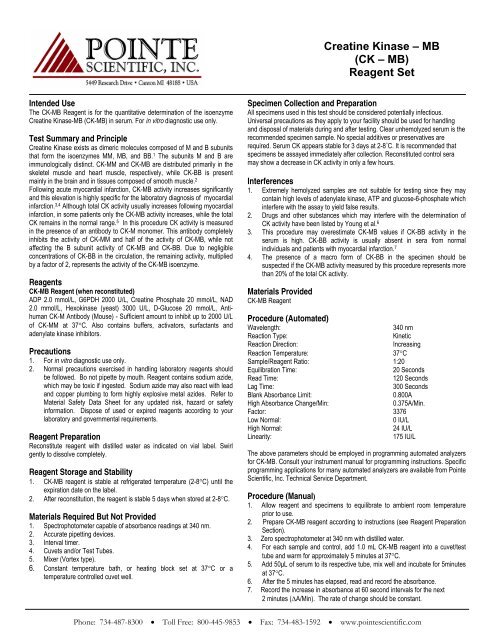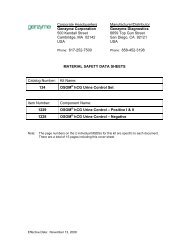Creatine Kinase â MB (CK â MB) Reagent Set - Pointe Scientific, Inc.
Creatine Kinase â MB (CK â MB) Reagent Set - Pointe Scientific, Inc.
Creatine Kinase â MB (CK â MB) Reagent Set - Pointe Scientific, Inc.
You also want an ePaper? Increase the reach of your titles
YUMPU automatically turns print PDFs into web optimized ePapers that Google loves.
<strong>Creatine</strong> <strong>Kinase</strong> – <strong>MB</strong><br />
(<strong>CK</strong> – <strong>MB</strong>)<br />
<strong>Reagent</strong> <strong>Set</strong><br />
Intended Use<br />
The <strong>CK</strong>-<strong>MB</strong> <strong>Reagent</strong> is for the quantitative determination of the isoenzyme<br />
<strong>Creatine</strong> <strong>Kinase</strong>-<strong>MB</strong> (<strong>CK</strong>-<strong>MB</strong>) in serum. For in vitro diagnostic use only.<br />
Test Summary and Principle<br />
<strong>Creatine</strong> <strong>Kinase</strong> exists as dimeric molecules composed of M and B subunits<br />
that form the isoenzymes MM, <strong>MB</strong>, and BB. 1 The subunits M and B are<br />
immunologically distinct. <strong>CK</strong>-MM and <strong>CK</strong>-<strong>MB</strong> are distributed primarily in the<br />
skeletel muscle and heart muscle, respectively, while <strong>CK</strong>-BB is present<br />
mainly in the brain and in tissues composed of smooth muscle. 2<br />
Following acute myocardial infarction, <strong>CK</strong>-<strong>MB</strong> activity increases significantly<br />
and this elevation is highly specific for the laboratory diagnosis of myocardial<br />
infarction. 3,4 Although total <strong>CK</strong> activity usually increases following myocardial<br />
infarction, in some patients only the <strong>CK</strong>-<strong>MB</strong> activity increases, while the total<br />
<strong>CK</strong> remains in the normal range. 5 In this procedure <strong>CK</strong> activity is measured<br />
in the presence of an antibody to <strong>CK</strong>-M monomer. This antibody completely<br />
inhibits the activity of <strong>CK</strong>-MM and half of the activity of <strong>CK</strong>-<strong>MB</strong>, while not<br />
affecting the B subunit activity of <strong>CK</strong>-<strong>MB</strong> and <strong>CK</strong>-BB. Due to negligible<br />
concentrations of <strong>CK</strong>-BB in the circulation, the remaining activity, multiplied<br />
by a factor of 2, represents the activity of the <strong>CK</strong>-<strong>MB</strong> isoenzyme.<br />
<strong>Reagent</strong>s<br />
<strong>CK</strong>-<strong>MB</strong> <strong>Reagent</strong> (when reconstituted)<br />
ADP 2.0 mmol/L, G6PDH 2000 U/L, <strong>Creatine</strong> Phosphate 20 mmol/L, NAD<br />
2.0 mmol/L, Hexokinase (yeast) 3000 U/L, D-Glucose 20 mmol/L, Antihuman<br />
<strong>CK</strong>-M Antibody (Mouse) - Sufficient amount to inhibit up to 2000 U/L<br />
of <strong>CK</strong>-MM at 37°C. Also contains buffers, activators, surfactants and<br />
adenylate kinase inhibitors.<br />
Precautions<br />
1. For in vitro diagnostic use only.<br />
2. Normal precautions exercised in handling laboratory reagents should<br />
be followed. Bo not pipette by mouth. <strong>Reagent</strong> contains sodium azide,<br />
which may be toxic if ingested. Sodium azide may also react with lead<br />
and copper plumbing to form highly explosive metal azides. Refer to<br />
Material Safety Data Sheet for any updated risk, hazard or safety<br />
information. Dispose of used or expired reagents according to your<br />
laboratory and governmental requirements.<br />
<strong>Reagent</strong> Preparation<br />
Reconstitute reagent with distilled water as indicated on vial label. Swirl<br />
gently to dissolve completely.<br />
<strong>Reagent</strong> Storage and Stability<br />
1. <strong>CK</strong>-<strong>MB</strong> reagent is stable at refrigerated temperature (2-8°C) until the<br />
expiration date on the label.<br />
2. After reconstitution, the reagent is stable 5 days when stored at 2-8°C.<br />
Materials Required But Not Provided<br />
1. Spectrophotometer capable of absorbance readings at 340 nm.<br />
2. Accurate pipetting devices.<br />
3. Interval timer.<br />
4. Cuvets and/or Test Tubes.<br />
5. Mixer (Vortex type).<br />
6. Constant temperature bath, or heating block set at 37°C or a<br />
temperature controlled cuvet well.<br />
Specimen Collection and Preparation<br />
All specimens used in this test should be considered potentially infectious.<br />
Universal precautions as they apply to your facility should be used for handling<br />
and disposal of materials during and after testing. Clear unhemolyzed serum is the<br />
recommended specimen sample. No special additives or preservatives are<br />
required. Serum <strong>CK</strong> appears stable for 3 days at 2-8˚C. It is recommended that<br />
specimens be assayed immediately after collection. Reconstituted control sera<br />
may show a decrease in <strong>CK</strong> activity in only a few hours.<br />
Interferences<br />
1. Extremely hemolyzed samples are not suitable for testing since they may<br />
contain high levels of adenylate kinase, ATP and glucose-6-phosphate which<br />
interfere with the assay to yield false results.<br />
2. Drugs and other substances which may interfere with the determination of<br />
<strong>CK</strong> activity have been listed by Young et al. 6<br />
3. This procedure may overestimate <strong>CK</strong>-<strong>MB</strong> values if <strong>CK</strong>-BB activity in the<br />
serum is high. <strong>CK</strong>-BB activity is usually absent in sera from normal<br />
individuals and patients with myocardial infarction. 7<br />
4. The presence of a macro form of <strong>CK</strong>-BB in the specimen should be<br />
suspected if the <strong>CK</strong>-<strong>MB</strong> activity measured by this procedure represents more<br />
than 20% of the total <strong>CK</strong> activity.<br />
Materials Provided<br />
<strong>CK</strong>-<strong>MB</strong> <strong>Reagent</strong><br />
Procedure (Automated)<br />
Wavelength:<br />
340 nm<br />
Reaction Type:<br />
Kinetic<br />
Reaction Direction:<br />
<strong>Inc</strong>reasing<br />
Reaction Temperature: 37°C<br />
Sample/<strong>Reagent</strong> Ratio: 1:20<br />
Equilibration Time:<br />
20 Seconds<br />
Read Time:<br />
120 Seconds<br />
Lag Time:<br />
300 Seconds<br />
Blank Absorbance Limit: 0.800A<br />
High Absorbance Change/Min:<br />
0.375A/Min.<br />
Factor: 3376<br />
Low Normal:<br />
0 IU/L<br />
High Normal:<br />
24 IU/L<br />
Linearity:<br />
175 IU/L<br />
The above parameters should be employed in programming automated analyzers<br />
for <strong>CK</strong>-<strong>MB</strong>. Consult your instrument manual for programming instructions. Specific<br />
programming applications for many automated analyzers are available from <strong>Pointe</strong><br />
<strong>Scientific</strong>, <strong>Inc</strong>. Technical Service Department.<br />
Procedure (Manual)<br />
1. Allow reagent and specimens to equilibrate to ambient room temperature<br />
prior to use.<br />
2. Prepare <strong>CK</strong>-<strong>MB</strong> reagent according to instructions (see <strong>Reagent</strong> Preparation<br />
Section).<br />
3. Zero spectrophotometer at 340 nm with distilled water.<br />
4. For each sample and control, add 1.0 mL <strong>CK</strong>-<strong>MB</strong> reagent into a cuvet/test<br />
tube and warm for approximately 5 minutes at 37°C.<br />
5. Add 50μL of serum to its respective tube, mix well and incubate for 5minutes<br />
at 37°C.<br />
6. After the 5 minutes has elapsed, read and record the absorbance.<br />
7. Record the increase in absorbance at 60 second intervals for the next<br />
2 minutes (ΔA/Min). The rate of change should be constant.<br />
Phone: 734-487-8300 • Toll Free: 800-445-9853 • Fax: 734-483-1592 • www.pointescientific.com
<strong>Creatine</strong> <strong>Kinase</strong> – <strong>MB</strong><br />
(<strong>CK</strong> – <strong>MB</strong>)<br />
<strong>Reagent</strong> <strong>Set</strong><br />
8. Determine the average absorbance per minute (ΔA/Min) and then<br />
multiply it by the factor 6752 (3376 x 2) for results in U/L<br />
NOTE: If cuvet/tube is not temperature controlled, incubate samples at<br />
37°C between readings.<br />
Calibration<br />
Calibration is not required. <strong>CK</strong>-<strong>MB</strong> activity is based on the micromolar<br />
extinction coefficient of NADH at 340 nm (see Results section).<br />
Quality Control<br />
Two levels of control material with known <strong>CK</strong>/<strong>CK</strong>-<strong>MB</strong> levels determined by<br />
this method should be analyzed each day of testing.<br />
Results<br />
1. Total <strong>CK</strong> Activity: Determine Total <strong>CK</strong> activity in serum according to<br />
the directions provided in the package insert for the <strong>Pointe</strong> <strong>Scientific</strong>,<br />
<strong>Inc</strong>. <strong>CK</strong> reagent.<br />
2. <strong>CK</strong>-B Activity: Values are derived based on the "absorptivity<br />
micromolar extinction coefficient" of NADH at 340 nm (0.00622). A unit<br />
per liter (U/L) of <strong>CK</strong>-B activity is that amount of enzyme which oxidizes<br />
one μmol/L of NADH per minute.<br />
Sensitivity: Based on an instrument resolution of A = 0.001, this procedure has a<br />
sensitivity of 4 U/L.<br />
Correlation: Serum <strong>CK</strong>-<strong>MB</strong> determinations by the procedure described (y) and by<br />
a similar method (Sigma) (x) on 40 sera, showed a correlation coefficient (r) of<br />
0.991 and a regression equation of y = 0.98x - 0.823.<br />
Linearity: This procedure is linear to 175 U/L. Samples having values greater than<br />
175 U/L should be diluted and reassayed.<br />
References<br />
1. Dawson, DM, et al., Biochem Biophys. Res. Comm 21: 346 (1965).<br />
2. Neumeir D: Tissue Specific Distribution of <strong>Creatine</strong> <strong>Kinase</strong> Isoenzyme, Lang,<br />
Editor, Springer Verlag, New York, 1981, pp 85-109.<br />
3. Wagner, et al, Circulation: 47 263 (1973).<br />
4. Bais R., Crit. Rev. Clin. Lab Sci. 18: 291 (1982).<br />
5. D'Souza JP et al, Clin. Biochem. 11: 204 (1978).<br />
6. Young, D.S., et al.: Clin Chem 21: 10 (1975).<br />
7. Lang, H. et al, Clin Chem 28: 1439 (1982).<br />
8. Wu AHB, Bowers CN Jr: Evaluation and comparison of immunoinhibition and<br />
immunoprecipitation methods for differentiating <strong>MB</strong> from BB and macro<br />
forms of creatine kinase isoenzymes in patients and healthy individuals. Clin<br />
Chem: 2017, 1982.<br />
<strong>CK</strong>-B activity (U/L) = __ΔA/Min._<br />
Absorptivity<br />
x _Total Volume_<br />
Sample Volume<br />
<strong>CK</strong>-B activity (U/L) = _ΔA/Min. x _1.050_<br />
0.00622 0.050<br />
<strong>CK</strong>-B activity (U/L) = ΔA/Min. x 3376<br />
3. <strong>CK</strong>-<strong>MB</strong> Activity (U/L) = <strong>CK</strong>-B activity (U/L) x 2<br />
% <strong>CK</strong>-<strong>MB</strong> Activity = _<strong>CK</strong>-<strong>MB</strong> activity (U/L) x 100_<br />
Total <strong>CK</strong> activity (U/L)<br />
NOTE: Samples having <strong>CK</strong>-<strong>MB</strong> values greater than 175 U/L are diluted 1:2<br />
(1 + 1) with distilled water, the assay repeated and results multiplied<br />
by the dilution factor of 2.<br />
Expected Values 8<br />
0 - 24 U/L (37°C)<br />
% <strong>CK</strong>-<strong>MB</strong> < 5.5 %<br />
This range should serve only as a guideline. It is recommended that each<br />
laboratory establish its own range of expected values, since differences exist<br />
between instruments, laboratories and local populations.<br />
Performance Characteristics<br />
Precision: Two pools were subjected to analysis over five consecutive days<br />
to determine total precision. Another two pools were subjected to triplicate<br />
analysis daily over a five day period to determine within run data. The data<br />
follows:<br />
Total Precision:<br />
Within Run:<br />
Pool 1 2 Pool 1 2<br />
Mean 32 122.8 Mean 34 132<br />
SD 3.1 9.2 SD 2.8 9.9<br />
CV 9.8% 7.4 % CV 8.2% 7.5%<br />
Rev. 8/09<br />
Manufactured for<br />
<strong>Pointe</strong> <strong>Scientific</strong>, <strong>Inc</strong><br />
Manufactured for <strong>Pointe</strong> <strong>Scientific</strong>, <strong>Inc</strong>.<br />
5449 Research Drive, Canton, MI 48188<br />
European Authorized Representative:<br />
Obelis s.a.<br />
Boulevard Général Wahis 53<br />
1030 Brussels, BELGIUM<br />
Tel: (32)2.732.59.54 Fax:(32)2.732.60.03 email: mail@obelis.net<br />
P803-C7562-02
















